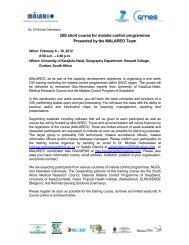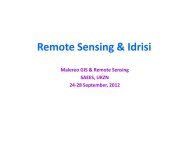Practical Manual - Malareo
Practical Manual - Malareo
Practical Manual - Malareo
You also want an ePaper? Increase the reach of your titles
YUMPU automatically turns print PDFs into web optimized ePapers that Google loves.
Task 1: Changing the Default CRS in QGIS and setting OTF projections as Default<br />
<br />
<br />
Open a new QGIS project.<br />
Access the Project Properties Window.<br />
By default the CRS should be WGS 84.<br />
<br />
<br />
<br />
<br />
To change the default CRS, search the list of CRS<br />
and find Cape/UTM Zone36S. (Look in the Universal<br />
Transverse Mercator submenu).<br />
Once this has been found, click on it to select it.<br />
To enable OTF projections, check the box at the Top<br />
top of the window marked Enable "on the fly" CRS<br />
transformation.<br />
Finally Click on Apply, then OK.<br />
The Default settings for QGIS have now been changed. In<br />
order to continue, go back and change the default CRS back<br />
to WGS84. In the Project Options Window, make sure that<br />
the Default manner in which QGIS deals with layers without<br />
a defined CRS is set to Prompt for CRS.<br />
Task 2: Working with Layer CRS<br />
<br />
<br />
<br />
<br />
<br />
Open a new QGIS Project.<br />
Add the layer called Fire_Stations from the Projections Data Folder.<br />
Next add the layer called eThekwini from the Projections Data folder.<br />
You will notice that a window has now opened and we are required<br />
to specify the CRS of the eThekwini layer. This is because the<br />
eThekwini layer does not have an associated CRS/projection<br />
specified (there is no .prj or .qpj file).<br />
Select WGS84 as the projection and click ok.<br />
QGIS for Malaria Page 33




